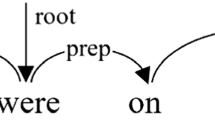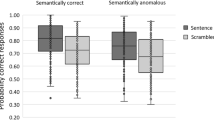Abstract
This paper discusses ways of determining whether the human parser is serial maintaining at most, one structural interpretation at each parse state, or whether it is parallel, maintaining more than one structural interpretation in at least some circumstances. We make four points. The first two counterclaims made by Lewis (2000): (1) that the availability of alternative structures should not vary as a function of the disambiguating material in some ranked parallel models; and (2) that parallel models predict a slow down during the ambiguous region for more syntactically ambiguous structures. Our other points concern potential methods for seeking experimental evidence relevant to the serial/parallel question. We discuss effects of the plausibility of a secondary structure in the ambiguous region (Pearlmutter & Mendelsohn, 1999) and suggest examining the distribution of reaction times in the disambiguating region.
Similar content being viewed by others
REFERENCES
Babyonyshev, M., Gibson, E., & Kaan, E. (in preparation). Syntactic and non-syntactic cues to sentence reanalysis. Manuscript, Massachusetts Institute of Technology.
Earley, J. (1970). An efficient context-free parsing algorithm. Communications of the Association of Computing Machinery, 13, 94–102.
Ferreira, F., & Henderson, J. M. (1990). The use of verb information in syntactic parsing: A comparison of evidence from eye movements and word-by-word self-paced reading. Journal of Experimental Psychology: Learning, Memory and Cognition, 16, 555–568.
Fodor, J. D., & Inoue, A. (1994). The diagnosis and cure of garden-paths. Journal of Psycholinguistic Research, 23, 407–434.
Gibson, E. (1991). A computational theory of human linguistic processing: Memory limitations and processing breakdown. Unpublished doctoral dissertation, Carnegie Mellon University, Pittsburgh, PA.
Gibson, E. (1998). Linguistic complexity: Locality of syntactic dependencies. Cognition, 68, 1–76.
Gibson, E., & Pearlmutter, N. (1998). Constraints on sentence comprehension. Trends in Cognitive Science, 2, 262–268.
Gorrell, P. G. (1987). Studies of Human Syntactic Processing: Ranked-Parallel versus Serial Models. Unpublished doctoral dissertation, University of Connecticut, Storrs, CT.
Jurafsky, D. (1996). A probabilistic model of lexical and syntactic access and disambiguation: Cognitive Science, 20, 137–194.
Just, M. A., & Carpenter, P. A. (1992). A capacity theory of comprehension: Individual differences in working memory. Psychological Review, 99, 122–149.
Kurtzman, H. S. (1985). Studies in syntactic ambiguity resolution. Unpublished Ph.D. dissertation, MIT, Cambridge, MA.
Lewis, R. L. (2000). Serial and parallel parsing. Journal of Psycholinguistic Research, 29, 241-248.
MacDonald, M., Pearlmutter, N., & Seidenberg, M. (1994). The lexical nature of syntactic ambiguity resolution. Psychological Review, 101, 676–703.
Pearlmutter, N. J., & Mendelsohn, A. (1999). Serial versus parallel sentence comprehension. Submitted manuscript.
Spivey M. J., & Tanenhaus, M. K. (1998). Syntactic ambiguity resolution in discourse: Modeling the effects of referential context and lexical frequency. Journal of Experimental Psychology: Learning, Memory, and Cognition, 24, 1521–1543.
Stevenson, S. (1994). Competition and recency in a hybrid network model of syntactic disambiguation. Journal of Psycholinguistic Research, 23, 295–322.
Tanenhaus, M. K., & Trueswell, J. C. (1995). Sentence comprehension. In J. Miller & P. Eimas (Eds.), Speech, language, and communication (pp. 217–262). San Diego, CA: Academic Press.
Trueswell, J. C., Tanenhaus, M. K., & Kello, C. (1993). Verb-specific constraints in sentence processing: Separating effects of lexical preference from garden-paths. Journal of Experimental Psychology: Learning, Memory, and Cognition, 19, 528–553.
Author information
Authors and Affiliations
Rights and permissions
About this article
Cite this article
Gibson, E., Pearlmutter, N.J. Distinguishing Serial and Parallel Parsing. J Psycholinguist Res 29, 231–240 (2000). https://doi.org/10.1023/A:1005153330168
Issue Date:
DOI: https://doi.org/10.1023/A:1005153330168




